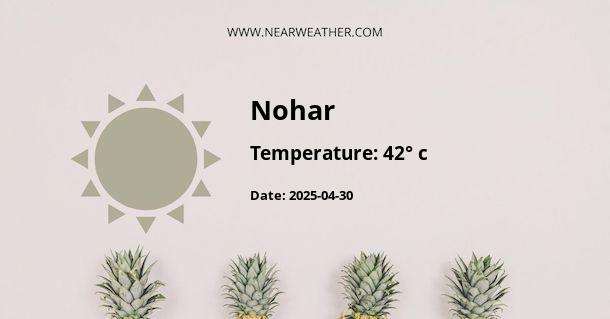Nohar, India: Climate and Weather Year Round
Nohar is a city located in the Hanumangarh district of the Indian state of Rajasthan. It is known for its arid climate and extreme temperatures. Understanding the climate and weather patterns in Nohar is essential for residents, tourists, and businesses operating in the region. In this article, we will explore the climate of Nohar throughout the year, including temperature ranges, precipitation levels, and seasonal variations.
1. Temperature
Nohar experiences a hot desert climate, characterized by scorching summers and chilly winters. The city is situated in the Thar Desert, which contributes to its extreme temperature fluctuations. Here is a breakdown of the average monthly temperatures in Nohar:
| Month | Average Maximum Temperature (°C) | Average Minimum Temperature (°C) |
|---|---|---|
| January | 20 | 5 |
| February | 25 | 8 |
| March | 32 | 14 |
| April | 38 | 20 |
| May | 42 | 26 |
| June | 42 | 30 |
| July | 39 | 29 |
| August | 38 | 28 |
| September | 37 | 26 |
| October | 35 | 19 |
| November | 29 | 11 |
| December | 23 | 6 |
The temperature in Nohar can reach as high as 42°C (108°F) during the summer months of May and June. These scorching temperatures make it important for residents and visitors to take precautions to avoid heat-related illnesses. In contrast, winter temperatures can drop to as low as 5°C (41°F) in January.
2. Precipitation
Nohar receives very limited rainfall throughout the year, typical of desert regions. The monsoon season, which lasts from July to September, brings the majority of the city's annual precipitation. Here are the average monthly rainfall amounts in Nohar:
| Month | Average Rainfall (mm) |
|---|---|
| January | 5 |
| February | 5 |
| March | 5 |
| April | 5 |
| May | 10 |
| June | 30 |
| July | 100 |
| August | 75 |
| September | 35 |
| October | 5 |
| November | 5 |
| December | 5 |
The monsoon season brings a significant amount of rainfall to Nohar, with July being the wettest month. However, even during the monsoon season, the total annual precipitation in Nohar is relatively low compared to other regions in India.
3. Seasonal Variations
Nohar experiences distinct seasons throughout the year, each with its own characteristics:
Summer (March to June): Summers in Nohar are scorching hot, with temperatures soaring above 40°C (104°F). Heatwaves are not uncommon during this period, and it is essential to stay hydrated and protected from the sun's intense rays. Monsoon (July to September): The monsoon season brings relief from the summer heat, with moderate rainfall. However, it is important to note that Nohar still remains relatively dry compared to other parts of India. Autumn (October to November): Autumn in Nohar sees a gradual decrease in temperature. The weather becomes more pleasant, making it an ideal time for outdoor activities. Winter (December to February): Winters in Nohar can be chilly, with temperatures dropping to as low as 5°C (41°F). It is advisable to carry warm clothing during this season.
It is worth mentioning that extreme weather events, such as dust storms and thunderstorms, can occur throughout the year in Nohar. These events can impact daily life and should be monitored closely.
In conclusion, Nohar experiences a hot desert climate with scorching summers and chilly winters. The temperature can reach as high as 42°C (108°F) during summers and drop to as low as 5°C (41°F) in winters. The city receives limited rainfall, with the monsoon season being the wettest period. Understanding the climate and weather patterns in Nohar is crucial for planning activities and ensuring personal safety in this arid region of Rajasthan, India.
A - Nohar's Latitude is 29.183331 & Longitude is 74.766670.
A - Weather in Nohar is 42° today.
A - Climate Conditions in Nohar shows clear sky today.
A - Humidity in Nohar is 9% today.
A - Wind speed in Nohar is 10.76 km/h, flowing at 43° wind direction. today.
